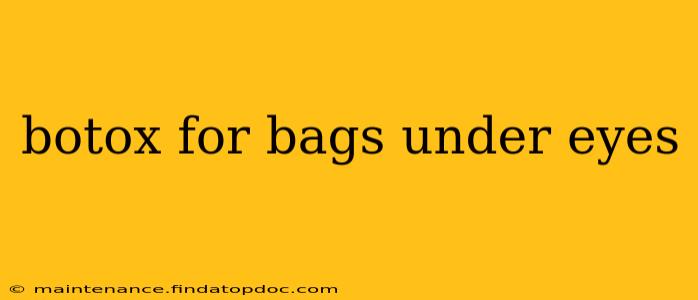Under-eye bags can be a significant source of concern, making individuals appear older and more tired than they feel. While various treatments exist, Botox has emerged as a popular option for addressing this cosmetic issue. This comprehensive guide explores the use of Botox for under-eye bags, addressing common questions and concerns. We'll delve into the procedure, its effectiveness, potential risks, and alternatives.
What is Botox, and How Does it Work?
Botox, short for Botulinum Toxin Type A, is a neurotoxin derived from a bacterium. When injected into specific muscles, it temporarily blocks nerve signals that cause muscle contraction. This muscle relaxation smooths out wrinkles and lines. For under-eye bags, Botox isn't directly targeting the fat deposits causing the puffiness, but rather the muscles that contribute to their appearance. Specifically, it targets the muscles around the eyes that can pull the skin downwards, exacerbating the appearance of under-eye bags.
Can Botox Get Rid of Under-Eye Bags?
This is a crucial question. Botox doesn't directly remove under-eye bags caused by fat accumulation or loose skin. However, it can improve their appearance by addressing the underlying muscle activity that might be contributing to their prominence. It's important to have realistic expectations. Botox might slightly lift the lower eyelid, making the bags appear less pronounced, but it won't eliminate them entirely.
What are the Alternatives to Botox for Under-Eye Bags?
Several alternatives exist for treating under-eye bags, depending on the cause and severity:
- Fillers: Dermal fillers, such as hyaluronic acid, can directly fill in the hollow areas under the eyes, reducing the appearance of bags.
- Blepharoplasty (Eyelid Surgery): This surgical procedure removes excess fat and skin, offering a more permanent solution for significant under-eye bags.
- Lifestyle Changes: Getting sufficient sleep, staying hydrated, and managing allergies can minimize puffiness.
- Topical Treatments: Some creams and serums claim to reduce puffiness, though their effectiveness varies.
Is Botox for Under-Eye Bags Painful?
The procedure is generally well-tolerated. Most patients report minimal discomfort, often described as a slight pinch or sting. A topical numbing cream may be applied beforehand to further minimize any discomfort.
How Long Does Botox Last for Under-Eye Bags?
The effects of Botox typically last for 3-4 months. After this period, the muscle activity gradually returns, and the effect diminishes. Repeat treatments are needed to maintain the results.
What are the Risks and Side Effects of Botox for Under-Eye Bags?
While generally safe, Botox injections carry some potential risks and side effects:
- Bruising: Minor bruising at the injection site is common and usually resolves within a few days.
- Swelling: Some swelling is possible, typically subsiding within a few days.
- Drooping Eyelids (Ptosis): This is a rare but possible complication. It usually resolves on its own, but in some cases, may require additional treatment.
- Asymmetry: Slight asymmetry is possible, though skilled injectors strive to minimize this risk.
It’s crucial to choose a qualified and experienced medical professional for Botox injections to minimize the risks.
How Much Does Botox for Under-Eye Bags Cost?
The cost of Botox for under-eye bags varies depending on the amount of Botox needed, the location of the clinic, and the injector's fees. It's best to consult with a qualified professional for a personalized cost estimate.
Is Botox for Under-Eye Bags Right for Me?
The suitability of Botox for under-eye bags depends on individual factors such as the cause of the bags, their severity, and your overall health. A consultation with a dermatologist or plastic surgeon is crucial to determine if Botox is the right treatment option for you and to discuss alternatives. They can assess your specific situation and recommend the most appropriate course of action.
This information is for educational purposes only and does not constitute medical advice. Always consult with a qualified healthcare professional before making any decisions about your health or treatment.
